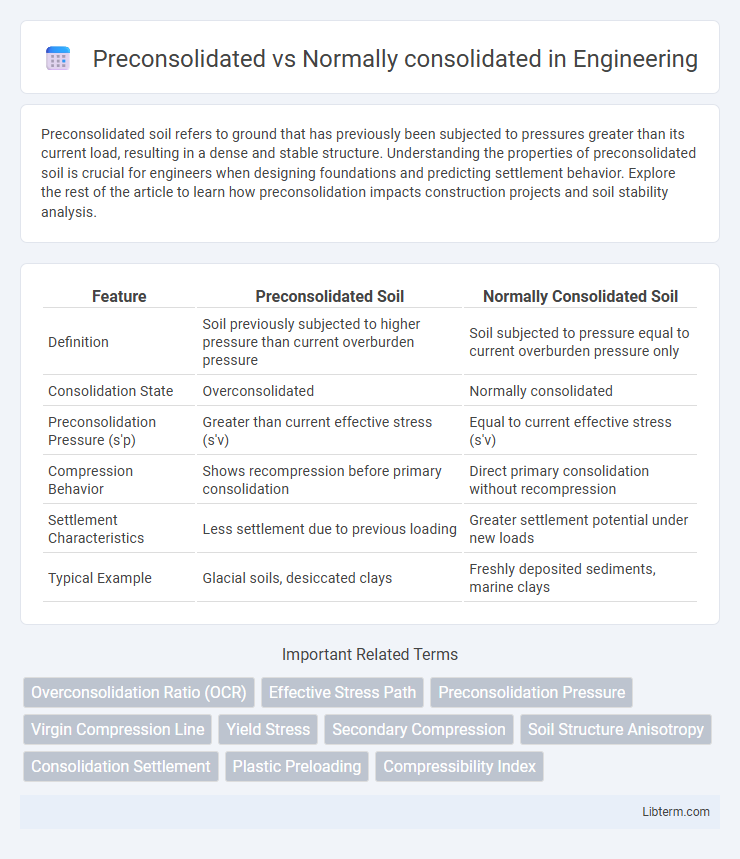Preconsolidated soil refers to ground that has previously been subjected to pressures greater than its current load, resulting in a dense and stable structure. Understanding the properties of preconsolidated soil is crucial for engineers when designing foundations and predicting settlement behavior. Explore the rest of the article to learn how preconsolidation impacts construction projects and soil stability analysis.
Table of Comparison
| Feature | Preconsolidated Soil | Normally Consolidated Soil |
|---|---|---|
| Definition | Soil previously subjected to higher pressure than current overburden pressure | Soil subjected to pressure equal to current overburden pressure only |
| Consolidation State | Overconsolidated | Normally consolidated |
| Preconsolidation Pressure (s'p) | Greater than current effective stress (s'v) | Equal to current effective stress (s'v) |
| Compression Behavior | Shows recompression before primary consolidation | Direct primary consolidation without recompression |
| Settlement Characteristics | Less settlement due to previous loading | Greater settlement potential under new loads |
| Typical Example | Glacial soils, desiccated clays | Freshly deposited sediments, marine clays |
Introduction to Soil Consolidation
Preconsolidated soil has previously experienced pressure greater than its current effective stress, resulting in a stiffer structure and lower compressibility compared to normally consolidated soil, which is undergoing maximum historical pressure for the first time. Understanding the difference between preconsolidated and normally consolidated soils is crucial for predicting settlement and designing foundations in geotechnical engineering. The overconsolidation ratio (OCR) quantifies this state, with OCR > 1 indicating preconsolidated soil and OCR = 1 representing normally consolidated soil.
Defining Preconsolidated and Normally Consolidated Soils
Preconsolidated soils have previously experienced a maximum effective stress higher than the current stress, resulting in a higher preconsolidation pressure that influences their compressibility and settlement behavior. Normally consolidated soils have not been subjected to stresses greater than the current effective stress, making them more prone to primary compression under loading. Understanding the distinct stress histories of preconsolidated and normally consolidated soils is essential for accurate geotechnical analysis and foundation design.
Key Differences Between Preconsolidated and Normally Consolidated Soils
Preconsolidated soils have experienced a maximum past effective stress greater than the current stress, causing them to be stiffer and less compressible, while normally consolidated soils are currently at their maximum past effective stress and exhibit higher compressibility and settlement potential. The preconsolidation pressure, or yield stress, distinguishes these two types by indicating the maximum historical overburden pressure the soil has sustained. In geotechnical engineering, understanding the difference in consolidation behavior is crucial for predicting settlement, designing foundations, and assessing soil stability under new loads.
Causes of Preconsolidation in Soils
Preconsolidation in soils occurs when the soil experiences a maximum past effective stress greater than the current stress, causing it to have a memory of previous loading conditions. Common causes include natural geological loading from overburden pressure, desiccation due to drying and shrinkage, and human activities such as excavation backfilling or the weight of temporary structures. Understanding these factors is crucial for predicting soil settlement and designing foundations effectively in both preconsolidated and normally consolidated soils.
Identification Methods for Soil Consolidation States
Preconsolidated soils are identified by a distinct maximum past effective stress greater than the current effective stress, while normally consolidated soils experience their current stress for the first time. The consolidation state can be determined using the consolidation curve from oedometer tests, where the preconsolidation pressure is marked by a change in curve slope. The Casagrande method and the Becker method are commonly applied to accurately estimate preconsolidation pressure, differentiating between preconsolidated and normally consolidated soil states.
Consolidation Curves and Their Interpretation
Preconsolidated soils exhibit a distinct yield point on their consolidation curves, indicating the maximum past vertical effective stress experienced, which separates the recompression and virgin compression zones. Normally consolidated soils show a continuous linear compression curve without a clear yield point, reflecting ongoing compression under the current effective stress. Interpreting consolidation curves involves identifying the preconsolidation pressure from the Casagrande method or other techniques to assess soil history and predict settlement behavior accurately.
Practical Implications in Geotechnical Engineering
Preconsolidated soils exhibit higher shear strength and lower compressibility compared to normally consolidated soils, impacting foundation design and settlement predictions in geotechnical engineering. Accurate identification of the Soil Overconsolidation Ratio (OCR) guides engineers in selecting appropriate construction techniques and evaluating stability under loading conditions. Practical implications include improved assessment of bearing capacity, reduced risk of excessive settlement, and informed decisions on soil improvement methods.
Settlement Analysis: Preconsolidated vs Normally Consolidated Soils
Preconsolidated soils exhibit lower settlement under additional load due to previous maximum stress levels exceeding current stresses, resulting in an overconsolidation ratio (OCR) greater than one. Normally consolidated soils experience higher settlement as they undergo primary consolidation corresponding directly to the applied load with an OCR equal to one. Settlement analysis relies on accurately identifying the soil consolidation state to predict compression behavior and estimate long-term deformation in foundation design.
Laboratory Testing for Consolidation Parameters
Preconsolidated soils have previously experienced a maximum past effective stress, making their current void ratio less compressible during laboratory consolidation tests, while normally consolidated soils are tested at their highest historical stress level, exhibiting greater primary consolidation settlements. In laboratory testing, the consolidation curve obtained from oedometer tests identifies the preconsolidation pressure (s'p), differentiating the soil behavior under loading; preconsolidated soils show a change in compression index at s'p, whereas normally consolidated soils display a consistent compression index throughout. Accurate determination of consolidation parameters such as compression index (Cc), recompression index (Cr), and preconsolidation pressure is essential for slope stability analysis, settlement prediction, and foundation design in geotechnical engineering.
Conclusion and Engineering Considerations
Preconsolidated soils exhibit a higher maximum past effective stress compared to normally consolidated soils, resulting in reduced settlement under future loading. Engineering design must account for soil consolidation history to accurately predict settlement and stability, emphasizing the importance of effective stress parameters and consolidation testing data. Proper identification ensures optimized foundation design and mitigates risks of excessive deformation or failure in geotechnical structures.
Preconsolidated Infographic

 libterm.com
libterm.com